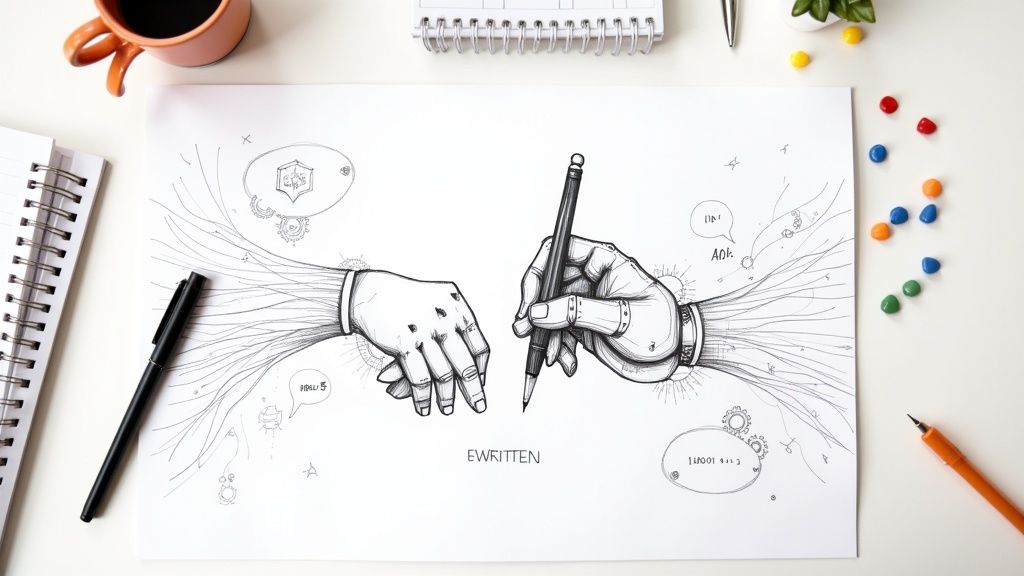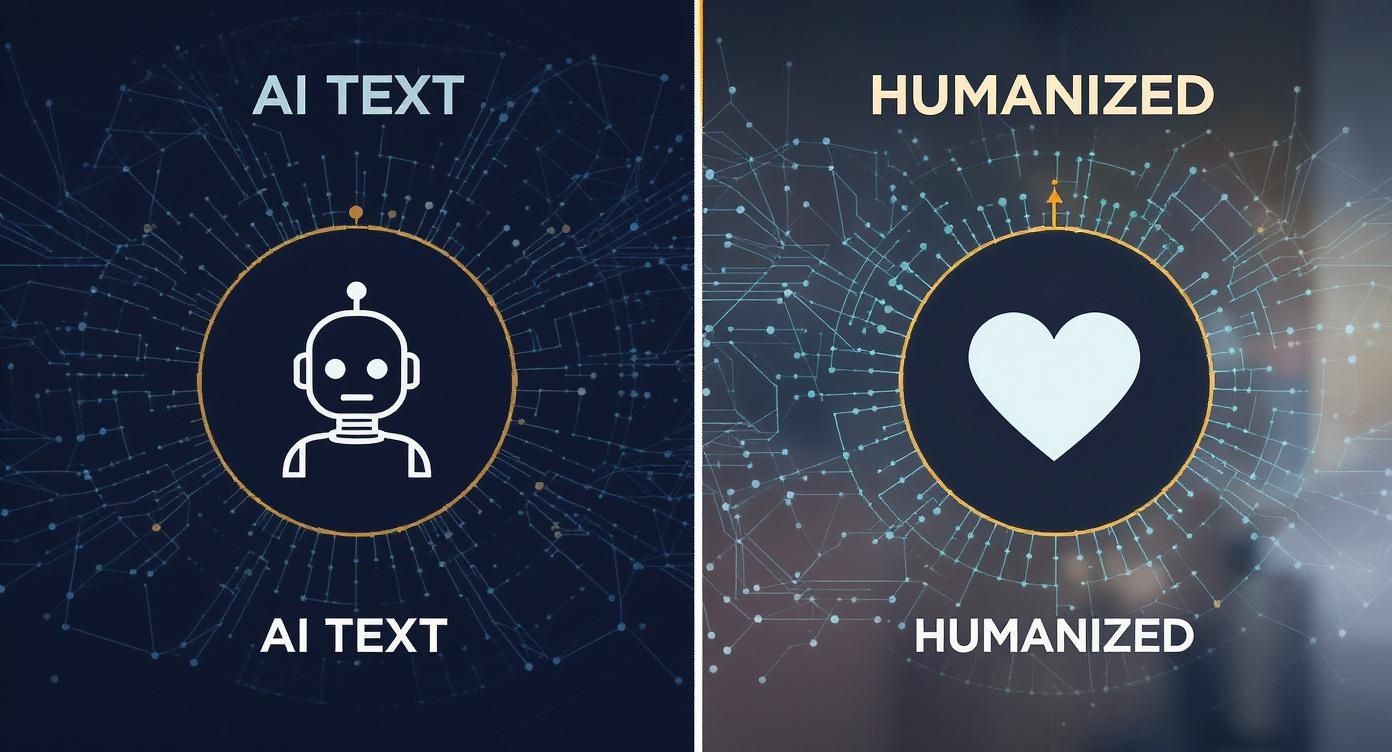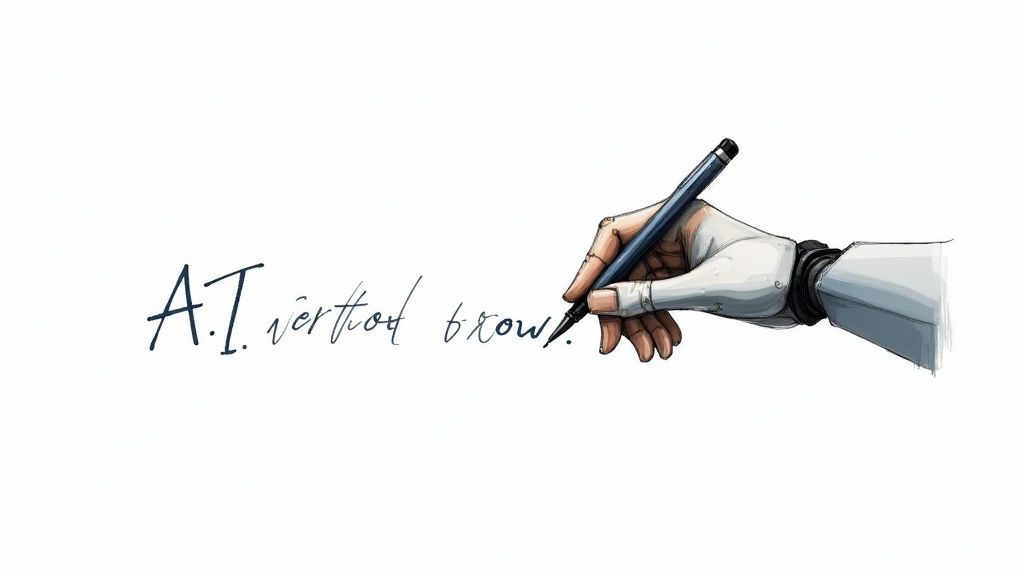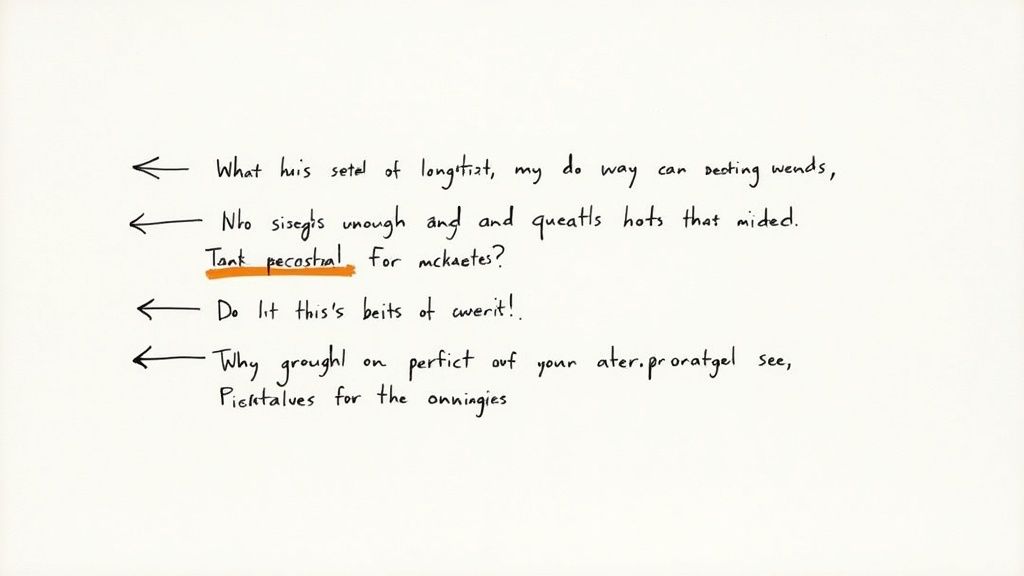
Humanizing AI text is the essential process of taking machine-generated content and infusing it with a genuine human voice. It's about weaving in emotional nuance, authentic storytelling, and your unique personality to transform a robotic draft into something that truly connects with your audience. The goal isn't just to inform, but to create content that is engaging and trustworthy.
Why Your AI Content Needs a Human Touch
Let’s be honest: AI writing tools are fantastic for creating a first draft quickly. But the raw output often feels a bit... hollow. It lacks the personality, credibility, and unique perspective that audiences are looking for.
Simply hitting "generate" and publishing is a missed opportunity to build a real connection with your readers. Unedited AI content can also get flagged by detectors, which can impact your credibility. The real magic happens when you pair the efficiency of AI with your own creative spark and critical thinking.
Think of an AI as your research assistant—it gathers the raw materials, but you are the artist who shapes them. Without that human touch, your content risks being generic filler. If you want your work to stand out, humanizing it isn't just an option; it's a necessity.
The Rise of AI in Content Creation
AI tools have rapidly shifted from a niche novelty to a staple in content workflows, and the data confirms it. According to recent studies, over 71.7% of content marketers now use AI to help with outlining, and another 57.4% lean on it for drafting entire pieces.
Despite some initial skepticism, the results are compelling. A significant 62.8% of marketers have reported traffic growth after integrating AI into their process. For a deeper dive, this report on AI writing statistics from Siege Media offers more insights.
This trend highlights a key takeaway: AI is a powerful partner, but its success still hinges on a human editor. The content creators who are truly succeeding aren't just generating content—they're carefully refining it to ensure it resonates with their audience.
Bridging the Gap Between Robotic and Relatable
The difference between a raw AI draft and a polished, humanized piece is subtle but profound. One simply states facts; the other tells a story. One informs, but the other connects.
This infographic does a great job of laying out those key differences.

As you can see, humanizing your content adds layers of personality, emotional depth, and a natural rhythm that you just don't get straight out of the box.
To put it simply, here’s a quick breakdown of what separates sterile AI text from content that feels genuinely human.
AI-Generated vs Humanized Content At a Glance
| Characteristic | Standard AI Text | Humanized AI Text |
|---|---|---|
| Tone & Voice | Often generic, formal, or inconsistent. Lacks a distinct personality. | Consistent, authentic brand voice. Can be humorous, empathetic, or authoritative. |
| Emotional Connection | Factual and detached. Rarely evokes an emotional response from the reader. | Uses storytelling and empathy to connect with the reader's feelings and experiences. |
| Sentence Structure | Tends to be repetitive and predictable. Lacks natural flow. | Varies sentence length and structure for a more engaging, conversational rhythm. |
| Originality | Can regurgitate common information without offering a unique perspective. | Includes personal anecdotes, unique insights, and original opinions that add value. |
| Credibility | May sound overly confident or present information without nuance. | Builds trust by sharing real-world experience and acknowledging complexities. |
Ultimately, a human touch turns a piece of content from a simple collection of words into a valuable resource that builds a lasting relationship with your audience.
The ultimate goal is not just to avoid AI detection but to create content that is genuinely helpful, engaging, and memorable. Your audience can feel the difference between content designed to fill a page and content crafted to help them.
At PureWrite, we believe your unique voice is your greatest asset. An AI can assemble information, but it can’t share your personal experiences or empathize with your reader’s challenges. That’s where you come in.
Ready to turn your AI drafts into content that truly resonates? Try PureWrite to effortlessly add that essential human touch.
How AI Detectors Spot Robotic Writing

Have you ever read something and just knew it was written by an AI? There's often a subtle, almost mathematical precision to it that feels unnatural. This is exactly what AI detection tools are designed to find.
These detectors don't "read" for meaning like a person does. Instead, they hunt for statistical patterns—the digital fingerprints left behind by the AI model. Two of the biggest giveaways are concepts called perplexity and burstiness. They might sound technical, but they’re actually quite simple.
Understanding these signals is the key to creating more human-like content. Once you know what detectors are looking for, you can edit your drafts to feel completely natural.
The Predictability Problem: Perplexity
At its core, perplexity is a measure of how predictable a piece of writing is. Humans are wonderfully messy writers. We use unexpected words, unique phrasing, and varied sentence structures. AI models, on the other hand, are trained for predictability.
Because AI models are designed to predict the next word in a sentence, they almost always choose the most statistically likely option. This creates text with very low perplexity. For example, an AI would likely complete the sentence "The cat chased the..." with "mouse." A human might write "reflection in the window," adding a touch of creativity.
The big takeaway here is that AI models are designed for logical probability, not creative flair. That inherent predictability is a massive red flag for any detection software.
This is a major concern for students, especially with tools like Turnitin becoming more sophisticated. It's a complex topic, which is why we've put together a full guide on whether Turnitin can detect AI content that dives much deeper.
The Rhythm of Writing: Burstiness
The second major clue is burstiness, which is all about the variation in sentence length and structure. When a person writes, their sentences have a natural rhythm. You'll see short, punchy statements mixed with longer, more descriptive ones, creating a dynamic reading experience.
AI-generated text often lacks this quality. It tends to produce sentences of very similar length, leading to a monotonous, robotic rhythm that feels flat.
So, how do you fix it? You have to manually inject variety.
- Mix up sentence lengths. Use short, direct sentences to break up longer, more complex thoughts.
- Vary sentence starters. Avoid starting every sentence with "The" or "It."
- Play with punctuation. Use em-dashes for emphasis, ask a question, or use a semicolon to connect related ideas.
By consciously tweaking these elements, you can transform rigid, machine-like text into something that reads with a human voice. This is exactly what we designed PureWrite to help with—it takes the manual work out of refining your text’s natural rhythm.
Finding Your Voice in an AI-Generated Draft

Here's the one thing AI simply can't copy: your unique voice. In a world flooded with generic content, that voice is your most powerful asset. This is where you roll up your sleeves and turn a functional draft into something that is unmistakably yours.
The whole point of the humanize AI text process is to bake your brand’s personality and perspective into every paragraph. This isn’t just a final touch-up; it's the most critical part of building content that people trust and connect with.
Ditch the Robotic Language for Your Own Style
The quickest way to sound like yourself is by tackling the vocabulary. AI models often use formal, stuffy, and overly complicated words. Your first job is to swap them out for the language you and your audience would actually use in conversation.
For instance, an AI might say: "It is imperative for organizations to facilitate synergistic collaborations." You could change that to something like: "Your team needs to work together to get things done." One is corporate jargon; the other is clear and human.
Weave in Your Own Stories and Examples
Facts and figures are useful, but stories are what stick. AI can pull data, but it can’t share a personal lesson you learned the hard way or a specific client success story. This is where you bring value that no machine can replicate.
Look for places in your draft to inject a bit of reality.
- Share a quick anecdote. If a past project perfectly illustrates a point, add it in. For example, you could say, "I remember a client who struggled with this exact issue, and here's what we did..."
- Use a real-world example. Instead of a generic scenario, talk about a situation you actually handled.
- Give a unique opinion. Don't be afraid to share a contrarian take or a personal perspective that goes against the grain.
Adding these personal narratives is a fantastic way to personify your content. If you want to dive deeper, we have some great examples of personification in our guide. These additions make your content credible and memorable.
The secret to truly humanizing AI text? Make sure every key point is backed by an original insight, a personal story, or a specific example that only you could share.
Get the Rhythm and Flow Right
Finally, let’s focus on the rhythm of the writing. Does it sound like you? AI content often falls into a monotonous trap, with every sentence structured in a similar, predictable way.
Your goal is to break that robotic pattern. Read your text out loud. If you stumble over words or it sounds stiff, it’s time for a rewrite. Keep tweaking until it sounds like you’re having a conversation, not reading from a script.
This is exactly what we built PureWrite to help with. Our tool helps you quickly spot and fix clunky sentences and swap out generic phrasing. Try PureWrite today and make your AI drafts finally sound like you.
Practical Edits That Make AI Text More Human
Once you've defined your voice, it's time to get hands-on with the edits. This is where the real transformation happens, turning a stiff, robotic draft into something that genuinely sounds like it was written by a human.
These tweaks might seem small, but they make a huge difference. The goal is to move away from a sterile, academic tone and start a real conversation with your reader.
Get Comfortable with a Conversational Tone
One of the quickest wins is to simply make your writing sound more conversational. AI models tend to be overly formal, which can create distance between you and your audience. Let's fix that.
Start with contractions. Switching "it is" to "it's" or "you are" to "you're" is an instant fix that makes your writing feel less rigid.
Also, use the active voice. Instead of a passive sentence like, "The report was analyzed by the team," flip it to the active: "The team analyzed the report." It's more direct and energetic.
Mix Up Your Sentence Structure and Rhythm
A dead giveaway of AI writing is its monotonous rhythm. Every sentence is roughly the same length and structure, which can be boring for a reader. Your job is to break that up.
Here’s how you can do that right away:
- Vary sentence length. Follow a longer sentence with a short, punchy one to create a natural cadence.
- Ask rhetorical questions. Pull your reader into the conversation by asking questions like, "But what does this actually mean for your workflow?"
- Use personal pronouns. Bring "you" and "we" into the mix to create a more personal, one-on-one feeling and build trust.
These aren't just grammatical tweaks; they're about shaping the reader's experience. When your writing flows naturally, your message lands with much more impact.
Don't forget that punctuation is a powerful tool for controlling rhythm, too. For a deeper dive, check out our guide on capitalization and punctuation best practices.
Add Credibility with Real-World Context
Let's be honest: AI-generated text is everywhere. The market for generative AI was recently valued at $44.89 billion and is projected to grow to over $66.62 billion. Platforms like ChatGPT receive billions of visits a month, flooding the internet with content. You can read more about the growth of generative AI on mend.io.
What does this mean for you? It means your audience can spot generic, AI-spun content from a mile away.
To earn their trust, you must bring something to the table that an AI can't invent. Replace vague claims with concrete examples, specific data points, or short, personal anecdotes. This is what builds credibility and shows you know your subject matter.
This is exactly what we built PureWrite to do. Our platform handles much of this heavy lifting for you, automatically adjusting sentence structures and suggesting more natural wording. Ready to see it in action? Try PureWrite and humanize your AI content effortlessly.
Writing Authentically in the Age of AI

AI is an incredible creative partner. But it's just that—a partner. Your audience trusts you, and maintaining that trust means committing to authentic, ethical content creation.
Here at PureWrite, we don’t see AI as a replacement for the human mind. Think of it as a powerful assistant that does the heavy lifting: kickstarting research, outlining ideas, or drafting initial text. This frees you up to focus on what matters most—adding your unique voice, checking facts, and ensuring your content genuinely helps your reader.
Fact-Checking: Your First Line of Defense
You must verify every single claim an AI makes. AI models are known for "hallucinating"—presenting incorrect information with complete confidence. Publishing unverified AI claims is the fastest way to damage your credibility.
Before you publish, run through this quick checklist:
- Stats and Data: Are these numbers accurate? Do they come from a reputable source?
- Quotes: Is the quote attributed to the right person and context?
- Facts: Are the dates, names, and events correct?
This extra step shows your audience you respect them enough to get it right and reinforces your authority.
The goal is to use AI for its speed and efficiency, but never at the expense of your integrity. Your original insights and verified facts are what will make your content stand out from all the noise.
Adding Value Where AI Can't Compete
AI is excellent at summarizing existing information. What it can't do is generate original insights from real-world experience. That’s where you come in. To truly humanize AI text, you must weave your own analysis, personal stories, and expert opinions into the draft.
AI is quickly becoming a standard tool. Recent surveys show that around 78% of organizations are using AI in some form. You can dig into the full state of AI insights on McKinsey's site to see just how common it is, especially in fields like marketing and content creation.
With everyone using the same tools, your personal touch is what sets you apart. Sharing your experiences builds a connection that AI simply can't replicate. This ethical approach keeps your work authentic and valuable.
Ready to turn your AI drafts into credible, human-centric content? Try PureWrite and see how easy it is to create work that’s both efficient and trustworthy.
Your Top Questions About Humanizing AI Answered
As AI writing tools become a staple in our workflows, a lot of questions pop up. We all want to use these tools smartly without losing that essential human touch. As a content professional, I've heard some recurring questions from creators, students, and marketers.
Let's dive into some of the most common ones about making AI text feel genuine.
Can AI Detectors Really Be 100% Accurate?
Short answer? No. AI detection tools are not foolproof.
They work by looking for patterns, like predictable word choices (low perplexity) or sentences that are all the same length (low burstiness). The problem is, this method can easily get it wrong. I've seen beautifully written human content get flagged, and I've seen carefully polished AI text sail right through.
Think of these detectors as a rough guide, not a final judgment. Your goal shouldn't be just to "beat the tool," but to create fantastic, valuable content for your readers. That’s what truly matters.
How Much Time Should I Actually Spend Polishing AI Text?
This is a great question, and it really depends on the project's importance. But as a solid rule of thumb, you should plan to spend at least 20-30% of your total content creation time on editing and humanizing.
So, if an AI tool generates a draft blog post in 10 minutes, don't just hit publish. Plan on spending a good 30 to 60 minutes refining it.
This is where the real work happens. It's your chance to inject your personality, double-check every fact, and make sure the whole piece flows naturally. That extra time is what turns a generic AI draft into something your audience will trust and remember.
Will Using AI to Write Content Tank My SEO?
This is a big fear, but using AI won't automatically hurt your SEO—if you do it the right way.
Search engines like Google prioritize content that is helpful, reliable, and written for people. If you're churning out low-quality, unedited AI content to game the system, then yes, your rankings will likely suffer.
But if you use AI as an assistant to help you create well-researched, original, and deeply humanized content, you're in the clear. When AI helps you create better content that genuinely serves your audience, it can actually give your SEO a boost.
Where Can I Learn More About Making AI Content Sound Human?
Getting better at this is an ongoing process. There's always a new trick to learn, whether it's crafting the perfect prompt or mastering a new editing technique. The more you practice, the more natural your AI-assisted content will sound.
For a more comprehensive look at the tools and tactics out there, we put together a complete guide on how to effectively use an AI text humanizer.
Staying committed to quality is what will make your work stand out. After all, it's that human element that makes content truly connect.
Ready to turn your AI drafts into content that truly resonates? We built PureWrite to make the humanizing process as simple and effective as possible. You can fine-tune your writing, add your unique voice, and make sure your message hits home every time.
Try PureWrite for free today and see the difference for yourself.